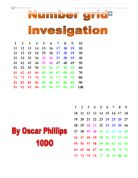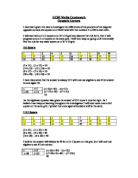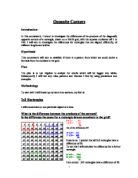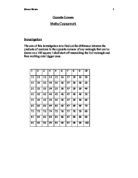Number grids. In this investigation I have been attempting to work out a formula that will find the difference between the products of the top left and bottom right of a number grid and the top right and bottom left of a number grid.
2 3 4 5 6 7 8 9 0 1 2 3 4 5 6 7 8 9 20 21 22 23 24 25 26 27 28 29 30 31 32 33 34 35 36 37 38 39 40 41 42 43 44 45 46 47 48 49 50 51 52 53 54 55 56 57 58 59 60 61 62 63 64 65 66 67 68 69 70 71 72 73 74 75 76 77 78 79 80 81 82 83 84 85 86 87 88 89 90 91 92 93 94 95 96 97 98 99 00 2 3 4 5 6 7 8 9 0 1 2 3 4 5 6 7 8 9 20 21 22 23 24 25 26 27 28 29 30 31 32 33 34 35 36 37 38 39 40 41 42 43 44 45 46 47 48 49 50 51 52 53 54 55 56 57 58 59 60 61 62 63 64 65 66 67 68 69 70 71 72 73 74 75 76 77 78 79 80 81 In this investigation I have been attempting to work out a formula that will find the difference between the products of the top left and bottom right of a number grid and the top right and bottom left of a number grid. 2 3 4 5 6 7 8 9 0 1 2 3 4 5 6 7 8 9 20 21 22 23 24 25 26 27 28 29 30 31 32 33 34 35 36 37 38 39 40 41 42 43 44 45 46 47 48 49 50 51 52 53 54 55 56 57 58 59 60 61 62 63 64 65 66 67 68 69 70 71 72 73 74 75 76 77 78 79 80 81 82 83 84 85 86 87 88 89 90 91 92 93 94 95 96 97 98 99 00 A 10x10 number grid If you choose any 2x2 box on a 10x10 number grid then the difference should equal 10...
I am going to investigate the difference between the products of the numbers in the opposite corners of any rectangle that can be drawn on a 100 square (10x10) grid
Opposite Corners Opposite Corners * Throughout this piece of work, the horizontal side will be referred to as the length, whilst the vertical side will be referred to as width. Introduction/Aim I am going to investigate the difference between the products of the numbers in the opposite corners of any rectangle that can be drawn on a 100 square (10x10) grid. I am going to investigate different rectangles, of different areas, lengths, widths and positioning on a grid. After finding a pattern, I will try and prove that it will work for other cases by using algebra and making an algebraic formula. As I go along, I will have to record any ideas I have or patterns I see. Afterwards, I will go on to investigate how this rule may differs on a different sized grid. 2x2 Square, 10x10 Grid 2 3 4 5 6 7 8 9 10 11 12 13 14 15 16 17 18 19 20 21 22 23 24 25 26 27 28 29 30 31 32 33 34 35 36 37 38 39 40 41 42 43 44 45 46 47 48 49 50 51 52 53 54 55 56 57 58 59 60 61 62 63 64 65 66 67 68 69 70 71 72 73 74 75 76 77 78 79 80 81 82 83 84 85 86 87 88 89 90 91 92 93 94 95 96 97 98 99 100 This is a 10x10 grid. On it (outlines in red) is a 2x2 square. Firstly, I’m going to see what the difference between the products of the corners is (D): 55x64=3520 54x65= 3510 3520-3510=10, D=10 Now: What
Opposite Corners
Opposite corners 1 2 3 4 5 6 7 8 9 10 11 12 13 14 15 16 17 18 19 20 21 22 23 24 25 26 27 28 29 30 31 32 33 34 35 36 37 38 39 40 41 42 43 44 45 46 47 48 49 50 51 52 53 54 55 56 57 58 59 60 61 62 63 64 65 66 67 68 69 70 71 72 73 74 75 76 77 78 79 80 81 82 83 84 85 86 87 88 89 90 91 92 93 94 95 96 97 98 99 00 On a 10*10 square grid, choose any 2*2 square, multiply the corners in that grid and then find the difference between the two corners investigate. 2 13 12 13 16 17 16 17 22 23 * 23 * 22 26 27 * 27 * 26 276 284 332 342 284-276=10 342-332=10 Difference=10 The two answers are the same. I think it would be the same for any 2*2 square. To prove this I will use algebra to show that in any 2*2 square the difference will 10. z- number in the top left corner z z+1 z(z+11)=z²+11z z+10z+11 (z+1)(z+10)=z²+11z+10 (z²+11z+10)-(z²+11z)=10 Difference = 10 This proves that with any 2*2 square the corners multiplied then subtracted always = 10 To further my investigations I am now going to
Opposite Corners. In this coursework, to find a formula from a set of numbers with different square sizes in opposite corners is the aim. The discovery of the formula will help in finding solutions to the tasks ahead as well as patterns involving Opposite
Introduction: The mathematical investigations that are about to be undertaken are all under one puzzle called Opposite Corners. In this coursework, to find a formula from a set of numbers with different square sizes in opposite corners is the aim. The discovery of the formula will help in finding solutions to the tasks ahead as well as patterns involving Opposite Corners. There are a few basic procedures to follow to achieve a basic understanding of the whole puzzle. A box consisting of numbers from 1 to 100, a 10 by 10 grid (arranged in a regular pattern) will aid in initiating an understanding for this piece. Procedure: . Place borders of four lines in order to enclose numbers arranged in a given grid. The enclosed numbers should form a perfect square. 2. Multiply the numbers that are found diagonally opposite and placed in the four corners of the box. 3. From the products obtained after multiplying, find the difference between them. An example is demonstrated on the next page. Below is a 10 by 10 grid. Here the numbers are arranged in 10 columns. 2 3 4 5 6 7 8 9 0 1 2 3 4 5 6 7 8 9 20 21 22 23 24 25 26 27 28 29 30 31 32 33 34 35 36 37 38 39 40 41 42 43 44 45 46 47 48 49 50 51 52 53 54 55 56 57 58 59 60 61 62 63 64 65 66 67 68 69 70 71 72 73 74 75 76 77 78 79 80 81 82 83 84 85
I am going to investigate by taking a square shape of numbers from a grid, and then I multiply the opposite corners to find the difference of these two results. Firstly I am going to start with a 10x10 grid
Gcse Math's - number grid coursework I am going to investigate by taking a square shape of numbers from a grid, and then I multiply the opposite corners to find the difference of these two results. Firstly I am going to start with a 10x10 grid and pick up 4 different squares, I will start with the 2x2 square. Then I move on and use the 3x3, 4x4 and the 5x5 square. number Left corner x right corner Right corner x left corner Products difference 3x24=312 4x23=322 0 2 4x25=350 5x24=360 0 3 25x36=900 26x35=910 0 I have noticed that the products difference of 2x2 squares in a 10x10 grid equal to 10. I predict if I move the 2x2 square to the right or down I will get the same answer. 4 34x45=1530 35x44=1540 0 My prediction is right. I am going to use algebra to test my results. n n+1 n+10 n+11 (n+1)(n+10)=n²+10+11n n(n+11)=n²+11n Products difference is equal to (n²+10+11n) - (n²+11n) =10 In the same grid I will now work out a 3x3 square. number Left corner x right corner Right corner x left corner Products difference 5 5x37=555 7x35=595 40 6 6x24=144 4x26=104 40 7 6x38=608 8x36=648 40 I have noticed that the products difference of 3x3 squares in a 10x10 grid equal to 40. I predict if I move the 3x3 square to the right or up I will get the same answer. 8 26x48=1248 28x46=1288 40 My prediction is right. I am going to
opposite corners
GCSE Maths Coursework Opposite Corners I have been given the task to investigate the differences of the products of the diagonal opposite corners of a square on a 10x10 Grid with the numbers 1 to 100 to start with. I will start with a 2 x 2 square on a 10 x 10 grid and discover the rule for it, then I will progress onto a 3 x 3 square on the same grid. I will then keep on going until I eventually find the rule for any sized square on a 10 x 10 grid. 2x2 Square 2 3 4 5 6 7 8 9 0 1 2 3 4 5 6 7 8 9 20 21 22 23 24 25 26 27 28 29 30 (2 x 11) - (1 x 12) = 10 (14 x 25) - (15 x 24) = 10 (8 x 17) - (7 x 18) = 10 (20 x 29) - (19 x 30) = 10 I have discovered that the answer is always 10 I will now use algebra to see if the answer is once again 10. n n+1 n+10 n+11 (n+1)(n+10) - n(n+11) (n2+11n+10) - (n2+11n) 0 As the algebraic equation also gives the answer of 10 I know it must be right. As I believe I can keep on learning throughout the investigation I will now move onto a 3x3 square on the same grid. I predict that once again all answers will be the same. 3 X 3 Square 2 3 4 5 6 7 8 9 0 1 2 3 4 5 6 7 8 9 20 21 22 23 24 25 26 27 28 29 30 (3 x 21) - (1 x 23) = 40 (6 x 24) - (4 x 26) = 40 (10 x 28) - (8 x 30) = 40 I believe the answer will always be 40 for a 3 x 3 square on this grid. So I will now use algebra

















